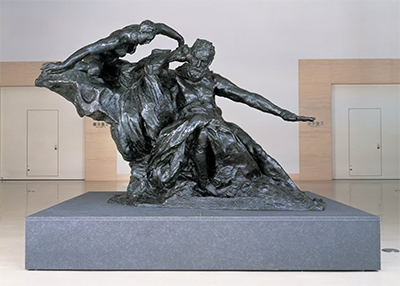Measuring 185cm x 285cm x 162cm, Auguste Rodin's Monument to Victor Hugo is a tribute to one of France's greatest men of letters and someone Rodin knew personally.
On receiving the commission in 1889 shortly after Hugo's death, Rodin chose to portray Hugo in a contemplative pose which he had used in other artwork, notably The Thinker (1880-1904). He also originally planned to include the three Muses behind Hugo whispering into his ears. However, this design was rejected by the committee for lacking a clear sense of form and for being too confusing.
In the bronze cast version, the Muses have been replaced by the single figure of Iris, representing Glory. Rodin chose to represent Hugo in exile on the island of Guernsey. His inspiration came from well-known photos taken by Hugo's son in 1853. However, Rodin’s statue shows the writer seated on some rocks and with his arm outstretched as if reaching out to France or to calm the waves. Rodin epitomises the writer as the incorruptible champion of the French republican cause. Hugo's nudity underlines his greatness which does not require the artifice which characterises the way other famous men are stylised in statues. Rodin also shocked his contemporaries by portraying Hugo in advanced years rather than in his prime.
Rodin’s original marble statue was commissioned to be a companion piece to Injalbert's Monument to Mirabeau and should have been installed at the northern transept of the Pantheon in Paris. However, it was felt that Rodin’s design did not harmonise with the existing artwork and so it found a home in the gardens of the Palais Royal. This is why the statue is also known as the Palais Royal Monument. Placed on a pedestal of uneven slabs, the outdoor setting, with trees behind, provided the ideal contrast for its translucent white as if the branches were "buffeted by the sea wind". The statue remained there for over 20 years (1909-33) before being moved to its present home in the Rodin Museum.
In 1950, on Hugo's 150th anniversary and in light of Rodin's increasing popularity, his forgotten sketch was revived and the Monument to Victor Hugo was cast in bronze. Fourteen years later, it was installed at its present home in the Rodin Museum, Paris.




